
Andy Lloyd's Dark Star Blog

Blog 34 (January 2016)
Massive Planet X Now Urgently Sought
by Top Planet-Hunters
We seem to be getting very close now to a discovery of a massive Planet X in the outer solar system. I heard this report on the evening BBC news, a slot which indicates the seriousness with which this subject is now being taken by the scientific community:
"American astronomers say they have strong evidence that there is a ninth planet in our Solar System orbiting far beyond even the dwarf world Pluto. The team, from the California Institute of Technology (Caltech), has no direct observations to confirm its presence just yet. Rather, the scientists make the claim based on the way other far-flung objects are seen to move. But if correct, the putative planet would have 10 times the mass of Earth.
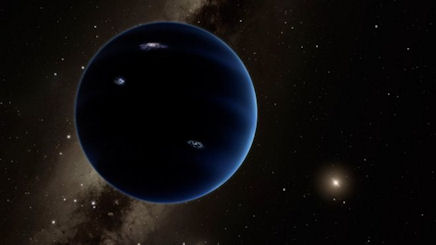
Image credit: Caltech/R. Hurt (IPAC)
"The Caltech astronomers have a vague idea where it ought to be on the sky, and their work is sure to fire a campaign to try to track it down. "There are many telescopes on the Earth that actually have a chance of being able to find it," said Dr Mike Brown. "And I'm really hoping that as we announce this, people start a worldwide search to go find this ninth planet."
The group's calculations suggest the object orbits 20 times farther from the Sun on average than does the eighth - and currently outermost - planet, Neptune, which moves about 4.5 billion km from our star. But unlike the near-circular paths traced by the main planets, this novel object would be in a highly elliptical trajectory, taking between 10,000 and 20,000 years to complete one full lap around the Sun." (1)
Dr Mike Brown is a premier academic planet-hunter, and for him to make this public pronouncement is quite unprecedented. One can only assume that his team have experienced a leak of their information, nudging him to go public with a paper in the Astronomical Journal (2). After all, it is only one month since similar speculation - that time by scientists working at the large array at Atacama in Chile - was widely criticised by astronomers for being presumptuous (3). Why risk similar criticism if they're not sure of what they're proposing? There is clearly heightened excitement going on at the moment, with the stakes running very high indeed.
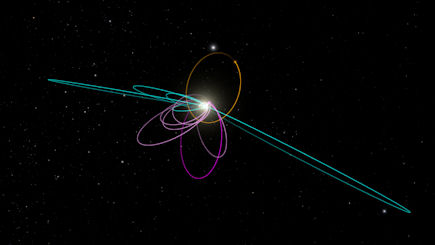
Image credit: Caltech
Here's what Dr Mike Brown said last month about the two proposals put forward by the Atacama teams:
"Mike Brown, a prominent California Institute of Technology astronomer and self-described “Pluto killer” who discovered several large TNOs that dethroned the former planet, unleashed another statistical argument against the claimed new planets on Twitter. “If it is true that ALMA accidentally discovered a massive outer solar system object in its tiny, tiny, tiny, field of view,” Brown tweeted, “that would suggest that there are something like 200,000 Earth-sized planets in the outer solar system. Which, um, no.
""Even better,” he added later, “I just realized that this many Earth-sized planets existing would destabilize the entire solar system and we would all die.” That said, Brown notes, “the idea that there might be large planets lurking in the outer solar system is perfectly plausible.”" (4)
So, whilst acknowledging the real potential for the presence of undiscovered large planets out there, he was sceptical that the Atacama team had been lucky enough to stumble upon such an object given the tiny fields of view they were studying when they picked these blips up. It is now clear that he has been on the hunt for this object himself for some time.
Dr Brown's interest lies in the anomalous movements of the extended scattered disk objects lying just beyond the Kuiper Belt, as well as non-random clustering of some of the KBOs themselves (2). I would hazard a guess that as more of these objects are verified (many by his team, no doubt) an increasingly discernible pattern is emerging, suggestive of the presence of a large planet. That work is clearly on-going:
"Continued analysis of both distant and highly inclined outer solar system objects provides the opportunity for testing our hypothesis as well as further constraining the orbital elements and mass of the distant planet." (2)
He seems to have an idea of where this 'Planet Nine', as he's calling it, is located; how big it is; how long it takes to move around the Sun (in it's "highly elliptical orbit"), and how far away it lies.
Dr Brown has been working closely with dynamicist Dr Konstantin Batygin for some time on this Planet X puzzle, according to the Caltech press release:
""Although we were initially quite skeptical that this planet could exist, as we continued to investigate its orbit and what it would mean for the outer solar system, we become increasingly convinced that it is out there," says Batygin, an assistant professor of planetary science. "For the first time in over 150 years, there is solid evidence that the solar system's planetary census is incomplete."
"...Batygin and Brown realized that the six most distant objects from [Chad]
Trujillo and [Scott] Shepherd's original collection [of distant KBOs] all follow elliptical orbits that point in the same direction in physical space. That is particularly surprising because the outermost points of their orbits move around the solar system, and they travel at different rates."It's almost like having six hands on a clock all moving at different rates, and when you happen to look up, they're all in exactly the same place," says Brown. The odds of having that happen are something like 1 in 100, he says. But on top of that, the orbits of the six objects are also all tilted in the same way—pointing about 30 degrees downward in the same direction relative to the plane of the eight known planets. The probability of that happening is about 0.007 percent. "Basically it shouldn't happen randomly," Brown says. "So we thought something else must be shaping these orbits."" (5)
Some of this data will sound eerily reminiscent of Zecharia Sitchin's work (6) - particularly the 30 degree downward tilt of the undiscovered planet's gravitational influence. It's highly elliptical. It's at least ten times the Earth's mass, they think (2). It's located about 600 Astronomical Units away, they think, with an orbit of tens of thousands of years - more like my own conclusions some years ago, as I came to realise that Sitchin's assumption of a 3600 year orbit was likely far too small a figure (7).
How easy this object will be to discover depends very much upon what point of its orbit it currently resides in. If near perihelion, then there are a great many telescopes on the Earth capable of discovering it. If, however, it is nearer its furthest point, or aphelion, then only the world's largest telescopes, such as the twin 10-meter telescopes at the W. M. Keck Observatory and the Subaru Telescope, all on Mauna Kea in Hawaii, will be capable of detecting it. Dr Brown hopes that an early release of this work will propel the scientific telescope-wielding community into action. I suspect he figures that his top reputation as arch-planet-hunter will prevent him from being roundly trashed by his peers, as happened to the Atacama scientists last month. Not only that, but this proposal ticks an awful lot of 'Nibiru' boxes, which will bring a lot of public interest to bear on this unfolding science.
But why has this object so far evaded detection? Why didn't the infra-red sky survey WISE discover Planet Nine? After all, it's very substantial indeed, and relatively close (lying in the gap between the Kuiper Belt and the inner Oort Cloud). That's a critical issue here, as the scientists working on the WISE data seemed to rule this possibility out in no uncertain terms, declaring that no Saturn-sized planet could be lurking within 10,000 AU (8). By contrast, Planet Nine may be a mere 600 AU, or less, albeit much smaller than Saturn by Batygin and Brown's reckoning. Even so, surely WISE should have spotted it?
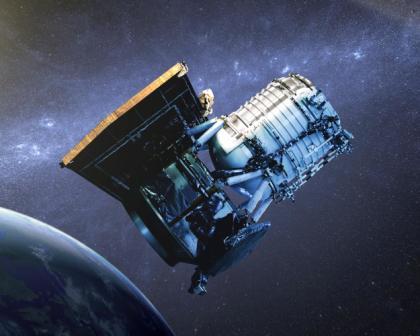
WISE
So what's the chances of finding it soon? As more data rolls in, Dr Batygin and Dr Brown seem to be honing in on this object, the parameters of its position, mass and orbits narrowing all the while. At the moment, they are still playing with a wide range of values, and conducting the astrophysical equivalent of war-games with them. There are no suggested coordinates for its position, beyond a wide range of space opposite to the bulk of the orbits of the non-random cluster of KBOs:
"A favored size for Planet X emerged—between five and 15 Earth masses—as well as a preferred orbit: antialigned in space from the six small objects, so that its perihelion is in the same direction as the six objects’ aphelion, or farthest point from the sun. The orbits of the six cross that of Planet X, but not when the big bully is nearby and could disrupt them." (9)
Batygin and Brown are already hard at work with the 8m Subaru telescope, but this immense area of the sky could take 5 years to search properly. This appears to be the factor driving their early rush to publication, hoping that other teams of astronomers, excited by the strength of their data analysis, join the hunt.
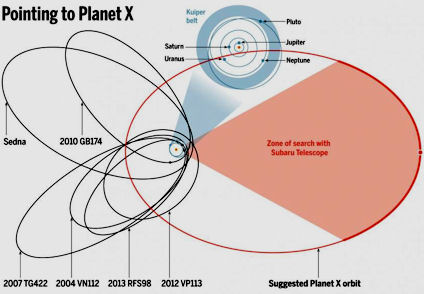
Image credit: (Data) JPL; Batygin and Brown/CALTECH;
(Diagram) A. Cuadra/Science (9)
There's other data that would help the hunt. Their model throws up intriguing predictions for another set of outer solar system objects, yet to be discovered. Finding them would help the team by confirming the veracity of their models, expanding their data set substantially, and thus helping to pinpoint the Planet Nine perturber more precisely:
"A unique prediction that arises within the context of our resonant coupling model is that the perturber allows for the existence of an additional population of high-perihelion KBOs that do not exhibit the same type of orbital clustering as the identified objects. Observational efforts aimed at discovering such objects, as well as directly detecting the distant perturber itself constitute the best path toward testing our hypothesis." (2)
It's not just the proverbial smoking gun they seek, but also some accompanying high-inclination grapeshot!
In terms of the origin of this distant object, the authors think that Planet Nine may have started out as a gas giant core among the ice giants Uranus and Neptune, before being scattered from this zone by the 'gaseous component of the [primordial] nebula'. But, at the same time, they don't seem to entirely rule out a much larger object than 10 Earth masses, particularly if the orbit is highly eccentric:
"Having identified an illustrative set of orbital properties of the perturber in the planar case, we demonstrated that an inclined object with similar parameters can dynamically carve a population of particles that is confined both apsidally and nodally. Such sculpting leads to a family of orbits that is clustered in physical space, in agreement with the data. Although the model proposed herein is characterized by a multitude of quantities that are inherently degenerate with respect to one another, our calculations suggest that a perturber on an a' ~ 700 AU, e' ~ 0.6 orbit would have to be somewhat more massive (e.g., a factor of a few) than m' = 10 M
E to produce the desired effect." (2)That, for me, is where things may yet get very interesting indeed! We could find that this object is substantially greater in mass than a 'Super-Earth', but is instead a compact gas giant. I've always thought that such an object would be found in a highly elliptical orbit sweeping through the zone between the Kuiper Belt and the inner Oort Cloud. After all, that would make sense of why that area is largely devoid of material. That judgement seems to correlate reasonably well with the results emerging from this latest scientific study. Ten Earth masses is a minimum, it seems, and could stretch to a much larger object if it's current position lies near aphelion (maybe as far as 1500 AU out?) and if it's orbit is highly eccentric (likely).

Planet 9 from Outer Space?
The burning question for me is why didn't the infra-red sky search WISE detect it? It should be eminently detectable at the sort of distances we're discussing. If the object is smaller than Neptune, and near it aphelion position between 600 and 1200 AU, then it may have slipped the net, thinks one of WISE's scientists:
"[Kevin] Luhman [an astronomer at Pennsylvania State University] notes that if Planet X is Neptune-sized or smaller, as Batygin and Brown say, WISE would have missed it. He says there is a slim chance of detection in another WISE data set at longer wavelengths—sensitive to cooler radiation—which was collected for 20% of the sky. Luhman is now analyzing those data." (9)
Either way, the indirect evidence is becoming compelling, and I think that the discovery of this object is now within sight. It may not turn out to be quite what Zecharia Sitchin had in mind. It's orbit will be tens of thousands of years, not 3600 (which, I think, was an educated guess on his part). It may no longer penetrate the planetary zone during its perihelion transit, but instead sweep through the massive gap between the Kuiper Belt and the inner Oort Cloud in its highly inclined, highly eccentric elliptical orbit. It may be a gaseous world with it's own 'system' of planets/moons.
Depending on its size, it may qualify as an ultra cool 'Dark Star'. But even if this is the case, Sitchin's general thrust about a mythical Planet X object may turn out to be right after all. If it quacks like a duck, and walks like a duck... well, you get the picture.
Written by Andy Lloyd,
20th - 23rd January 2016
References:
1
) BBC News "Case made for 'ninth planet'" 20 January 20162) Konstantin Batygin & Michael Brown "Evidence for a Distant Giant Planet in the Solar System" The Astronomical Journal, 151:2, 20 January 2016,
3) A. Lloyd "Atacama Astronomers Claim Double Discovery of Planet X" 12 December 2015
andylloyd.org/darkstarblog33.htm
4) Lee Billings "Astronomers Skeptical Over "Planet X" Claims" 10 December 2015
scientificamerican.com article
5) Caltech Press Release "Caltech Researchers Find Evidence of a Real Ninth Planet" 20 January 2016
6) Zecharia Sitchin "Genesis Revisited" p326, Avon 1990
7) Andy Lloyd "Dark Star: The Planet X Evidence" Timeless Voyager Press, 2005
8) W. Clavin & J. Harrington "NASA's WISE Survey Finds Thousands of New Stars, But No 'Planet X'" 7 March 2014
9) Eric Hand "Astronomers say a Neptune-sized planet lurks beyond Pluto" 20 June 2016, with thanks to Lee
Planet Nine Constellations Predicted by Sitchin, and IRAS
A week on, and Dr Mike Brown and Dr Konstantin Batygin, the two astrophysicists proposing the existence of their 'Planet Nine', have sketched out the range of orbits which their object might be moving through, including its all-important approximate perihelion and aphelion positions. Essentially, Brown and Batygin consider the perihelion position of the Planet Nine body to be in a broad region around the zodiacal constellations Scorpius/Sagittarius (R.A. = ~16hrs), whilst the aphelion position of Planet Nine is likely in the equally broad Orion/Taurus area (R.A. = ~4hrs) (1,2).
This aphelion/perihelion axis is of great importance to me, because it is precisely the one that arises out of Zecharia Sitchin's work on the much defamed Planet Nibiru. Actually, the similarities go deeper than that, as we shall see.
Where the Caltech team have decided upon a preferred inclination to the ecliptic of 30 degrees (2), decades ago Zecharia Sitchin agreed with Dr Robert Harrington's assertion that Planet X also had an inclination to the ecliptic of about 30 degrees (3). Sitchin believed that this 30 degree inclination corresponds with 'The Way of Anu' in ancient Sumerian texts (3). Compare this to the orbital properties of Planet Nine: The Caltech team noted that "the orbits of the six objects [they studied] are also all tilted in the same way—pointing about 30 degrees downward in the same direction relative to the plane of the eight known planets" (4).

Image credit: Caltech
More specifically, here's that inclination again with further orbital parameters which provide their best fit for the data:
"The capture of KBOs into long-lived apsidally anti-aligned orbital configurations occurs, with variable success, across a significant range of companion parameters (semi-major axis a ~ 400–1500 AU, eccentricity e ~ 0.5–0.8). For their best-fit nominal simulation, they selected a = 700 AU, e = 0.6, M = 10 ME (meaning a body with ten times the mass of Earth), orbital inclination i = 30°, and initial argument of perihelion ω = 150° (compared to roughly 310° the average for the six analyzed TNOs)." (2)
So what of the constellations? Both sets of proposed parameters imply that Planet X spends most of its time either above or below the ecliptic, and, all importantly, that its aphelion and perihelion position lie in Orion and Sagittarius. Sitchin quotes the Book of Job when describing the orbit of Nibiru/Marduk:
"Alone he stretches out the heavens and treads upon the farthest Deep.
He arrives at the Great Bear, Orion and Sirius and the constellations of the south...
He smiles his face upon Taurus and Aries; From Taurus to Sagittarius He shall go." (3)
These are eerily similar constellations to those being discussed by the Caltech scientists. Combined with the high inclination, and the elliptical nature of the orbit, then Sitchin looks like he really was on the money. He considered the size of Nibiru/Marduk to be between that of the Earth and Uranus, too, and would have been perfectly comfortable with the Caltech hypothesis that Planet Nine is an ice giant core - a planet essentially like Uranus stripped of much of its extensive outer atmosphere.
The only thing Sitchin appears to have got wrong is the orbital period, which he assumed to be 3,600 years, based upon the importance attached to the Sumerian quirky numerical system's 'royal number', the Sar (5). Perhaps he would have been better off opting for the šar'u - 36,000 or 10 Sars in Old Babylonian (6). This would have corresponded more closely to the proposed Planet Nine orbital period.
By the time I wrote my book 'Dark Star' back in 2005, I had already realised that 3600 years was too short a periodicity, and broke with Sitchin's central thinking. I argued that the Kuiper Cliff, at about 48 AU, marked the least possible perihelion distance, to prevent widespread scattering within the solar system over time. My diagrams in that book (7) are very similar to Brown's and Batygin's now, eleven years on. I drew an elliptical orbit which stretched from a point beyond the Kuiper Belt to the inside edge of the inner Oort Cloud.
In my analysis of Sitchin's work on Nibiru, I concluded that the perihelion constellation was Sagittarius and the aphelion position close to Orion (7). I appear to have got the exact same axis as the Caltech team, but 180 degrees in reverse. This may yet prove accurate, though, because the work they have published is based upon the assumption (which they strongly argue for (8)) that the clustered orbits of the six extended scattered disk objects should be anti-aligned with respect to Planet Nine. If they are aligned, on the other hand, then the aphelion/perihelion positions are exactly opposite of the Caltech positions. In that case, I'd be right, with perihelion in Sagittarius. We'll see.
The Caltech team are keen for astronomers everywhere to get involved in the hunt, and have helpfully outlined the regions which have not yet been thoroughly examined by various sky searches in the past:
"The Catalina [the blue zone in their diagram, opposite], PanSTARRS transient [yellow zone] & moving object [red zone] surveys do a great job of ruling out much of the sky. They generally miss the galactic plane, but that is mostly filled in by WISE [green zone], at least at closest approach. Though we can't be 100% sure yet. The biggest unexplored territory is where, statistically, it is most likely to be: near aphelion. Sadly, aphelion is also very close to the Milky Way galaxy. Ugh. So where is it? Probably distant. 500 AU+. Probably fainter than 22nd magnitude. Very possibly in the middle of the Milky Way galaxy." (1)
But haven't we already had sightings of a massive Planet X in both Orion, and also in Sagittarius before? Planet X geeks (of whom I am, of course, a prime example) will remember the controversy surrounding a report in the Washington Post back in 1983. A public announcement was made that a Jupiter-sized Planet X body had been discovered by the IRAS infra-red sky survey, in Orion (9). It has become the subject of any number of Planet X conspiracy theories since then. It seems most likely that the IRAS astronomers instead found either a dense gas cloud in our own Galaxy, or a Ultra-luminous Infrared Galaxy (10). But what if they had really spotted Planet X, in the position proposed in 2016 by the Caltech scientists?
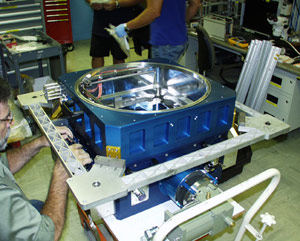
PanSTARRS
Similarly, there was a report on a mysterious IRAS object in Sagittarius (11), which created some controversy at the time between factions of the international team working on the IRAS data (12).
It is curious, then, that there should be two published scientific reports back in 1983 about warm objects found in the exact same constellations now marked out as likely positions for a Planet Nine body. Both of these zones are densely packed with stars due to their proximity to the Milky Way. Both have been of interest to Planet X hunters for years due to their association with the proposed orbit of the mythological Sumerian planet Nibiru.
I heard an interview on the BBC news on Sunday with Dr Mike Brown (13), and he roundly dismissed any talk of Nibiru or the Sumerian 'Epic of Creation' mythology being connected with his proposed Planet Nine. Yet, as I have shown in this short article, the similarities between these two theories are really pretty remarkable.
Written by Andy Lloyd, 26th January 2016
References:
1
) Mike Brown "Where is Planet Nine?" 25th January 2016, with thanks to Barryfindplanetnine.blogspot.com/2016/
2) "Planet Nine"
wikipedia.org/wiki/Planet_Nine
3) Zecharia Sitchin "Genesis Revisited" p325-8, Avon Books 1990
4) Caltech Press Release "Caltech Researchers Find Evidence of a Real Ninth Planet" 20 January 2016
5) Overview of Metrological Systems
6) Luke Hodgkin "A History of Mathematics: From Mesopotamia to Modernity" Oxford University Press
7) Andy Lloyd "Dark Star: The Planet X Evidence" Timeless Voyager Press 2005 pp164-8, pp78-83
8) Konstantin Batygin & Michael Brown "Evidence for a Distant Giant Planet in the Solar System" The Astronomical Journal, 151: 2, 20 January 2016,
9) Thomas O'Toole "Possibly as Large as Jupiter; Mystery Heavenly Body Discovered" 30 December 1983
10) "Bad Astronomy "The IRAS Incident"
11) M. Redfern & N. Henbest "Has IRAS Found a Tenth Planet?" New Scientist, 10th November 1983
12) Andy Lloyd "The Secrecy Surrounding the 1983 IRAS Discovery" 18 September 2014
andylloyd.org/darkstarblog18.htm
13) BBC News, Radio 4, 1pm, 24th January 2016
The Mysterious Origin of Ceres
The bright spots in some of Ceres' craters, imaged by the Dawn space probe, have created plenty of speculation about surface ices and salts reflecting the Sun's light (1). The number of these spots is now about 130 across the surface of the main belt asteroid (2). The most intense location for these bright spots is in the Occator crater, and analysis of the areas concerned has led to the conclusion that the highly reflective materials on the surface of these craters are indeed salts. These salts may have been left behind after the sublimation of briny water-ice driven to the asteroid's surface after an impact with another asteroid.
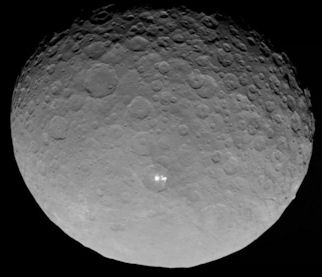
The scientific arguments about what's going on on the surface of Ceres are compounded by the observation of a 'haze' in the Occator crater, which fluctuates with a diurnal rhythm (3). This may be suggestive of a variable atmosphere in the crater, associated with extant ice. Perhaps this points to a geological process still going on within Ceres, which would be most unexpected given its size and lack of companion to drive such an internal mechanism. The probable presence of water ice on Ceres is suggestive of formation of this asteroid beyond the Solar System's 'snowline':
"Of particular interest is a bright pit on the floor of crater Occator that exhibits probable sublimation of water ice, producing haze clouds inside the crater that appear and disappear with a diurnal rhythm. Slow-moving condensed-ice or dust particles may explain this haze. We conclude that Ceres must have accreted material from beyond the 'snow line', which is the distance from the Sun at which water molecules condense." (4)
Now, the snowline of the solar system is located somewhere between 1.7 and 2.7 Astronomical Units, depending upon how you calculate it (5), and the semi-major axis for Ceres is about 2.8 AU. So, Ceres straddles the universal snowline, and is clear over the border with the lower theoretical value of 1.7 AU.
(Note that the Earth is well within the snowline, implying that the Earth should not have water at all, as it would have been water vapour here when the planet was forming - but that's another story, albeit of great interest to this blog).
If Ceres manages to remain over-the-snowline border for water-ice, it most certainly does no such thing for ammonia, which has been found to be abundant on the asteroid. Simply put, Ceres is located too close to the Sun to have ammonia. Yet it has. How?
"There are at least two possible explanations for how Ceres acquired its large inventory of ammonia. One is that it formed much farther from the sun, perhaps even beyond Neptune, where conditions were cool enough for ammonia to condense. In that case, it could easily have incorporated ammonia. Subsequent gravitational jostling among the new residents of the solar system could have propelled Ceres into its present orbit between Mars and Jupiter. Another possibility is that Ceres formed closer to where it is now but that debris containing ammonia from the outer solar system drifted inward and some of it ultimately fell onto the dwarf planet. If enough made its way to Ceres, the ground would be covered with the chemical, just as VIR observed [Dawn's visible and infrared mapping spectrometer instrument]." (3)
Once again, the solar system which, on the face of it, appears tranquil and settled, has revealed a past with any number of skeletons lurking in its closet. The largest asteroid in the main belt is either an interloper from the outer solar system, or else the inner solar system was bombarded by debris from without, containing an abundance of ammonia.
A third alternative, raised by my colleague Lee Covino, is that ammonia may have been produced by internal geophysical processes, below the ocean, of a watery planet which once occupied the asteroid belt zone (i.e. 'Tiamat). Such processes have previously been proposed to explain the initial formation of various biochemicals important to the emergence of life (6).
Upon the catastrophe event that split Tiamat apart - causing the main chunk of the planet to migrate inwards to become Earth - the asteroid belt would have been formed by the debris, including ammonia-contaminated water. It's not clear what the scale of the production of ammonia through this process is, and whether it would be sufficient to explain the abundance of the chemical on Ceres, but given that the authors of the report at the Carnegie Institute discuss ammonia's role as a greenhouse gas in the atmosphere (6), one assumes there would be a considerable quantity!
Written by Andy Lloyd,
2nd January 2016
References:
1
) Andy Lloyd "More Anomalies on Ceres" 27 June 2015andylloyd.org/darkstarblog27.htm
2) Marc Rayman "Dawn Journal: Science on Ceres" 1 January 2016
3) Andrew Rivkin "Dawn at Ceres: A haze in Occator crater?" 21 July 2015
4) A. Nathues et al. "Sublimation in bright spots on (1) Ceres" Nature, 528, 237–240, 10 December 2015
5) Harvard Astronomy 201B "The “Snow Line” in Protoplanetary Disks"
6) Carnegie Institute "Ammonia From The Earth's Deep Oceans: A Key Step In The Search For Life's Origins" 24 September 1998, with thanks to Lee
A Mirror Matter Companion?
A new essay by Robert Schoch PhD, associate professor of Natural Sciences at the College of General Studies in Boston, discusses the possible existence of a companion 'Second Sun'.

Dr Schoch is, of course, the academic who first questioned the weathering patterns on Sphinx; realising that they must have been created by rainfall in an earlier, wetter period from Egypt's distant past.
Here's the abstract introducing his new article:
"Lately I have found myself thinking about the question of whether or not our Sun might have a companion. Is the Sun part of a binary or multiple star system? Astronomers have estimated that anywhere from 30% to over 80% of all stars may be members of binary or multiple star systems, so why not the Sun? The classic response is that if there was a "Second Sun," then we should see it! But the situation may not be so simple."
I understand that the article delves into how the Earth came to have its precessional wobble, and also the missing angular momentum of the solar system. Without having read the complete article, published in 'Atlantis Rising' magazine, it seems that Dr Schoch has been partly influenced on Walter Cruttenden's 'Lost Star' book from 2005 (2), as Graham Hancock was at the time.
In my opinion, the problem with Cruttenden's original hypothesis is that the object would have to be about 80 Jupiter masses for this to work at the distance he was discussing - which would be a top-of-the-range brown dwarf binary companion (3), even extending into the range of red dwarf stars, which Dr Schoch also alludes to in his article. This is not realistic, as such a huge object would be highly detectable with even basic equipment in that circumstance.
Perhaps in response to this key issue, Mr Cruttenden's hypothesis has evolved into a more nebulous model of a moving solar system over time (4). I hope Dr Schoch also lowers his sights to a sub-stellar companion, like a ultra cool sub-brown dwarf (a Y dwarf in astronomical parlance).
Even if the precession issue may be a red herring, the angular momentum thing is almost certainly a real anomaly, and it's good to see another researcher (especially one with Schoch's scientific credentials) seriously consider the sub-stellar companion solution to the solar system's increasing bag of mysteries. Dr Schoch references the excellent 2015 article by the American engineer R.F. regarding the angular momentum anomaly (5,6) and a proposed Dark Star companion.
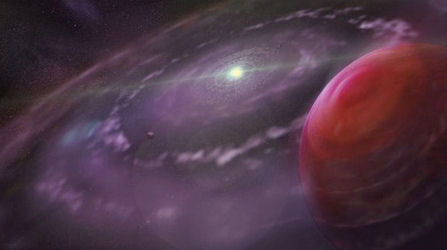
So what of this concept of a 'mirror matter' companion? The available extract from the magazine article discusses the speculative 2001 paper by R. Foot and Z. Silagadze discussing a potential 'mirror star' orbiting the Sun:
"Mirror matter is predicted to exist if parity is an unbroken symmetry of nature. Currently, there is a large amount of evidence that mirror matter actually exists coming from astrophysics and particle physics. One of the most fascinating (but speculative) possibilities is that there is a significant abundance of mirror matter within our solar system. If the mirror matter condensed to form a large body of planetary or stellar mass then there could be interesting observable effects. Indeed studies of long period comets suggest the existence of a solar companion which has escaped direct detection and is therefore a candidate for a mirror body.
"Nemesis, hypothetical "death star" companion of the Sun, proposed to explain biological mass extinctions, may potentially be a mirror star. We examine the prospects for detecting these objects if they do indeed exist and are made of mirror matter." (7)
A more recent academic paper, written by V. Netchitailo, a physicist specialising in lasers, includes the potential for stars made of Dark Matter (8), which I reviewed in a previous blog (9). There are also other non-Dark Matter alternatives being considered for massive, enigmatic occulting objects discovered roaming the Milky Way (10). There may be a place for an exotic solution to this mystery, but it does involve a considerable leap in faith. To my mind, an ultra-cool failed star is far more likely to eventually prove to be the solution.
Written by Andy Lloyd,
3rd January 2016
References:
1)
Robert Schoch "Reflecting on Our Sun: Might It Have a Mirror Matter Companion?" January 2016, with thanks to Chuck2) Walter Cruttenden "Lost Star of Myth and Time" St. Lynn's Press, 2005
3) Andy Lloyd "Dark Star: The Planet X Evidence" Timeless Voyager Press, 2005
![]() The Dark Star: The Planet X Evidence
The Dark Star: The Planet X Evidence
4) Walter Cruttenden "History and Celestial Time"
binaryresearchinstitute.com article
5) R.F. (full name known to me) "Speculations on the Sun's Dark Star Companion, According to Physics" 14 February 2015
6) Andy Lloyd "Missing Angular Momentum and the Dark Star" 23 February 2015
andylloyd.org/darkstarblog23.htm
7) R. Foot and Z. Silagadze “Do mirror planets exist in our solar system?”, Acta Phys.Polon. B32: 2271-2278, 15 April 2001
8) V. Netchitailo "5D World-Universe Model. Multicomponent Dark Matter", Journal of High Energy Physics, Gravitation and Cosmology, 1: 55-71, 2015
9) Andy Lloyd "A Star Made of Dark Matter" 17 April 2015
10) Jonathan O'Callaghan "Astronomers Claim To Have Found Enormous Invisible Structures Hiding In The Milky Way" 21 January 2016, with thanks to Bruce
11) K. Bannister et al. "Real-time detection of an extreme scattering event: Constraints on Galactic plasma lenses" Science, 351: 6271, 354-356, 22 Jan 2016
Water from Comets Not of This Earth
The preconception of an ice-laden traveller through the solar system took a bit of a battering when the first images of cometary bodies was returned by visiting probes over the last few years. Far from being pristine balls of glimmering ice, these looked more like dirty rocks. Water ice, although prevalent in the emitted comas of the comets, was not apparent upon their actual surfaces. More careful imaging by the Rosetta probe has now revealed breaks in the dark, rugged silicate and organic laden surface of comet 67P, showing interior water ice gleaming within (1).
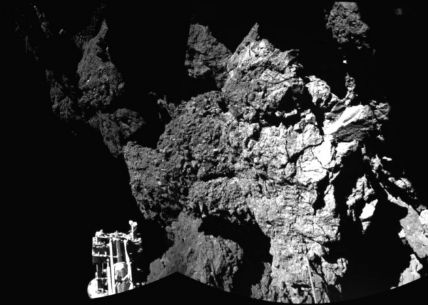
So, these maybe dirty snowballs after all, just disguised by
the residue left on the object's surface:
"The surface of comet 67P, like most comets, is
primarily covered by dark organic materials that appear almost black.
That's because as comets fly toward the sun, they are exposed to warm
temperatures that cause volatiles like water ice on their surface to
sublimate - or go directly from solid to gas. What remains on the
crust are what are known as refractory materials. These include
silicates similar to rocks, sand and dirt on Earth and carbonaceous
materials. Because these materials do not sublimate, the comet's surface
becomes increasingly organic and silicate rich over time."
(1)
It's regrettable that Rosetta's Philae lander has not
been back online since losing contact some months ago (2), because the
plucky little lander could have brought some of its best scientific
equipment to bear on the crucial issue of the constituents of this comet
water ice. After all, it now looks like the expected ice lies just
a few feet below the darkened soil and rocky surface of the comet.
This is in contrast to the initial theoretical expectation of an
abundance of gleaming surface ice long held by astronomers. But at
least it's there, which should provide impetus for future missions to
comets, including some drilling equipment built into the lander rig.
In terms of the hydrogen/deuterium ratio of the comet's water, we are
left with just the data from the water sublimating off the comet into
space, creating the comet's glorious tail. This water is very
heavy in deuterium, compared to the Earth's own aqueous deposits,
implying that the water on Earth came not from comets, but (if it came
from anywhere at all) the asteroids (3). This is a discussion
that's been had several times on this blog (4) and is crucial to
understanding the origins of not just our water, but of the Earth
itself. Written by Andy Lloyd,
References:
1)
Deborah Netburn "Water ice found on the surface of comet 67P" 14 January 2015, with thanks to John2) Andrew Griffin "Philae lander is probably completely dead as European Space Agency’s mission approaches its end," 12 January 2016
3) Ian Sample 'Rosetta discovers water on comet 67p like nothing on Earth' 11 December 2014, with thanks to Lee
4) Andy Lloyd "Earth's Primordial Waters" 24 November 2015
andylloyd.org/darkstarblog32.htm
Beautiful Winged Disk Tattoo
One of my correspondents, Cigarette Smoking Man, wrote to me recently and sent me this wonderful image of a Mesopotamian winged disk tattoo (1), most likely of the Zoroastrian deity Ahura Mazda or, possibly, the Assyrian deity Ashur. I wanted to share it with you.

CSM wrote:
"This gal is
thinking ahead! If some really tall, really smart guys
step out of freshly landed spaceships, she be part of
the “in crowd"! I thought you would get a laugh as
an artist! Did not find any Tats with Nibiru orbit
– maybe 9th Planet Tats coming soon - hahaha"
(2)
Come to think of it, a tattooed mystery planetary orbit would make a rather good plot device in a Dark Star novel. Anyway, this reminded me of an article I wrote about one of footballer David Beckham's tattoos some years ago, one of which was a rather enigmatic Winged Cross motif (3). Grabbed a lot of attention, which is something Beckham's particularly adept at doing.
Written by Andy Lloyd,
References:
1)
pinimg.com original with thanks to CSM2) Correspondence from Cigarette Smoking Man, 21 January 2016
3) Andy Lloyd "David Beckham's Winged Cross Tattoo" 15 June 2004
UK Dark Star Talk
I will be speaking at the Weird Weekend North conference on Saturday 2nd April 2016 at Rixton-with-Glazebrook Community Hall, Near Warrington, Cheshire on the subject of "The Hunt for Planet X". Here's a provisional outline of what I will include in my talk:

"For over 100 years, astronomers have searched for a missing planet in our solar system, located beyond Neptune. In this talk, I will provide a potted history of this search; an overview of the many varieties of Planet X considered (Nemesis, Nibiru, Tyche and, more recently, 'Planet Nine'); and the latest scientific evidence driving this hunt to a whole new level. I will also discuss mythological ideas about Planet X, connected with ancient aliens and human origins."
facebook.com Weird-Weekend-North
I don't give many lectures, so this is a rare opportunity to come and hear me discuss this subject, as well as field some questions, and sign a few books. Here are some links about the event, which is running over the course of the weekend, and covers a highly eclectic range of subjects:
glenvaudrey weird-weekend-north

You can keep informed of updates by following me on Twitter:
![]()
Or like my Facebook Page: https://www.facebook.com/darkstarandylloyd